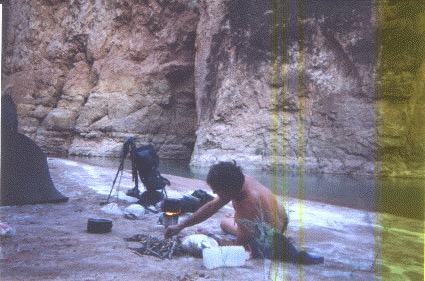
camp steve salt trail.jpg
Oops! Steve says the above
picture is the Little Colorado I think.
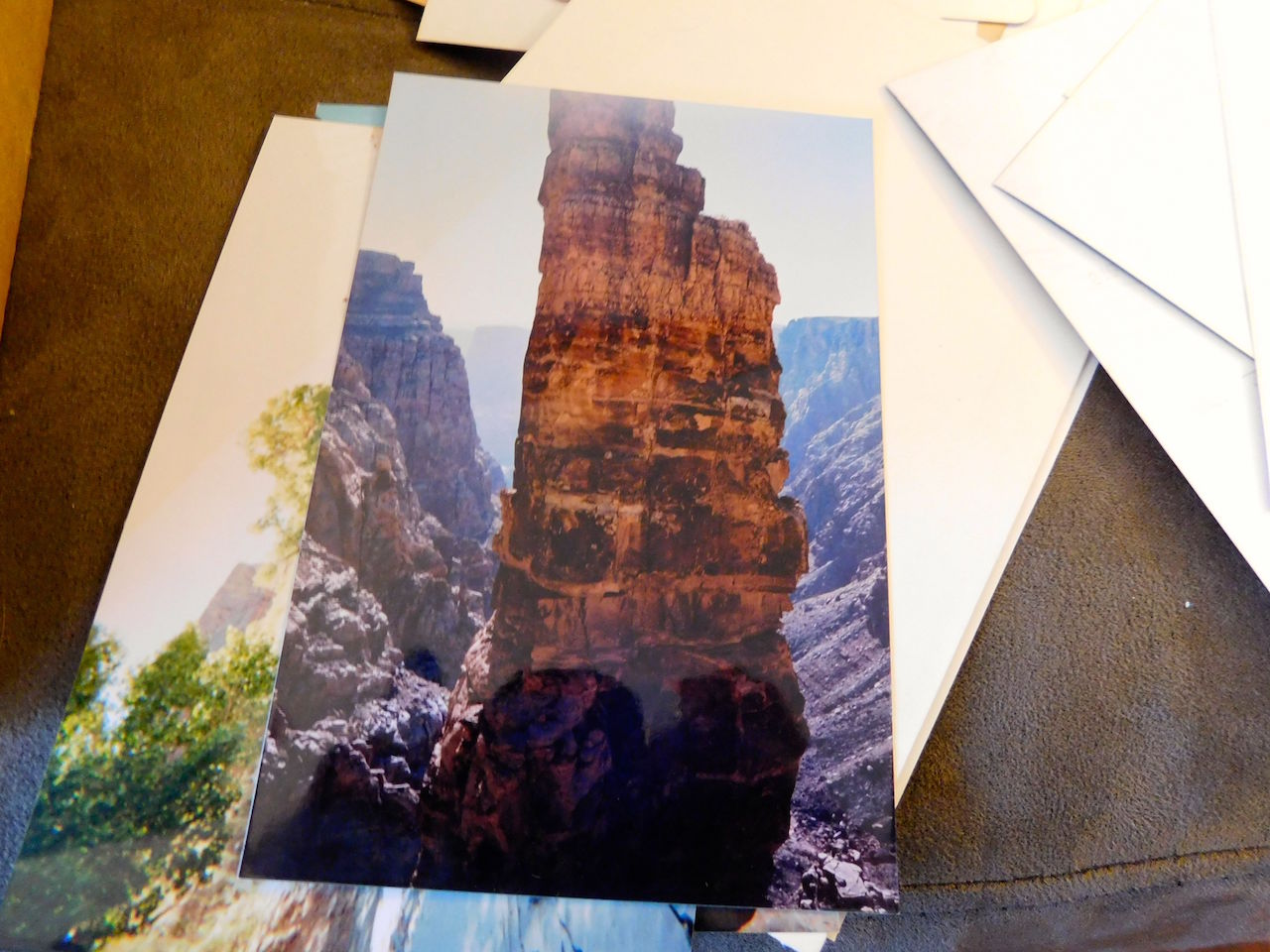
Salt Trail 2002 I think.jpg
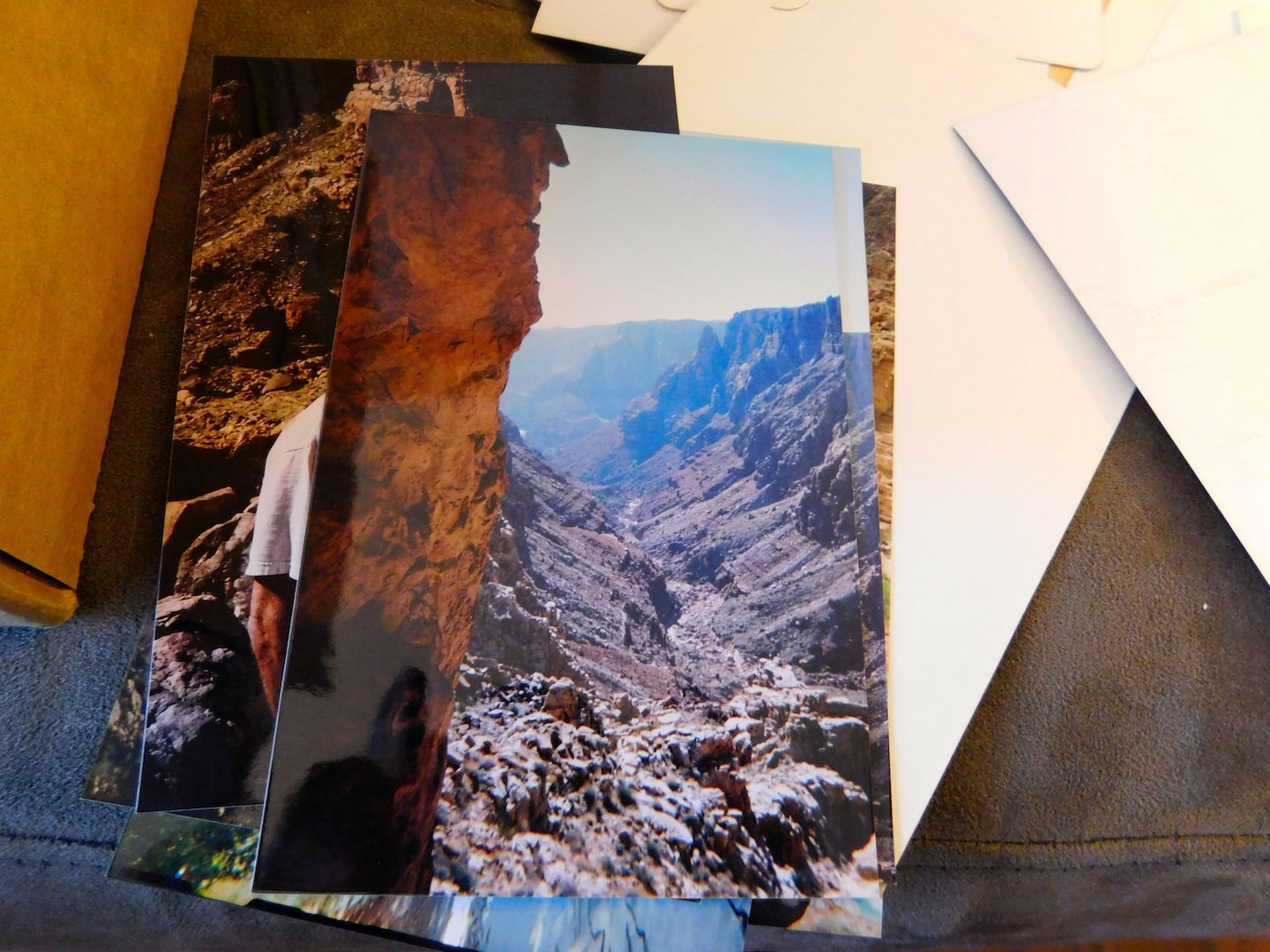
Salt Trail 2002 v.jpg
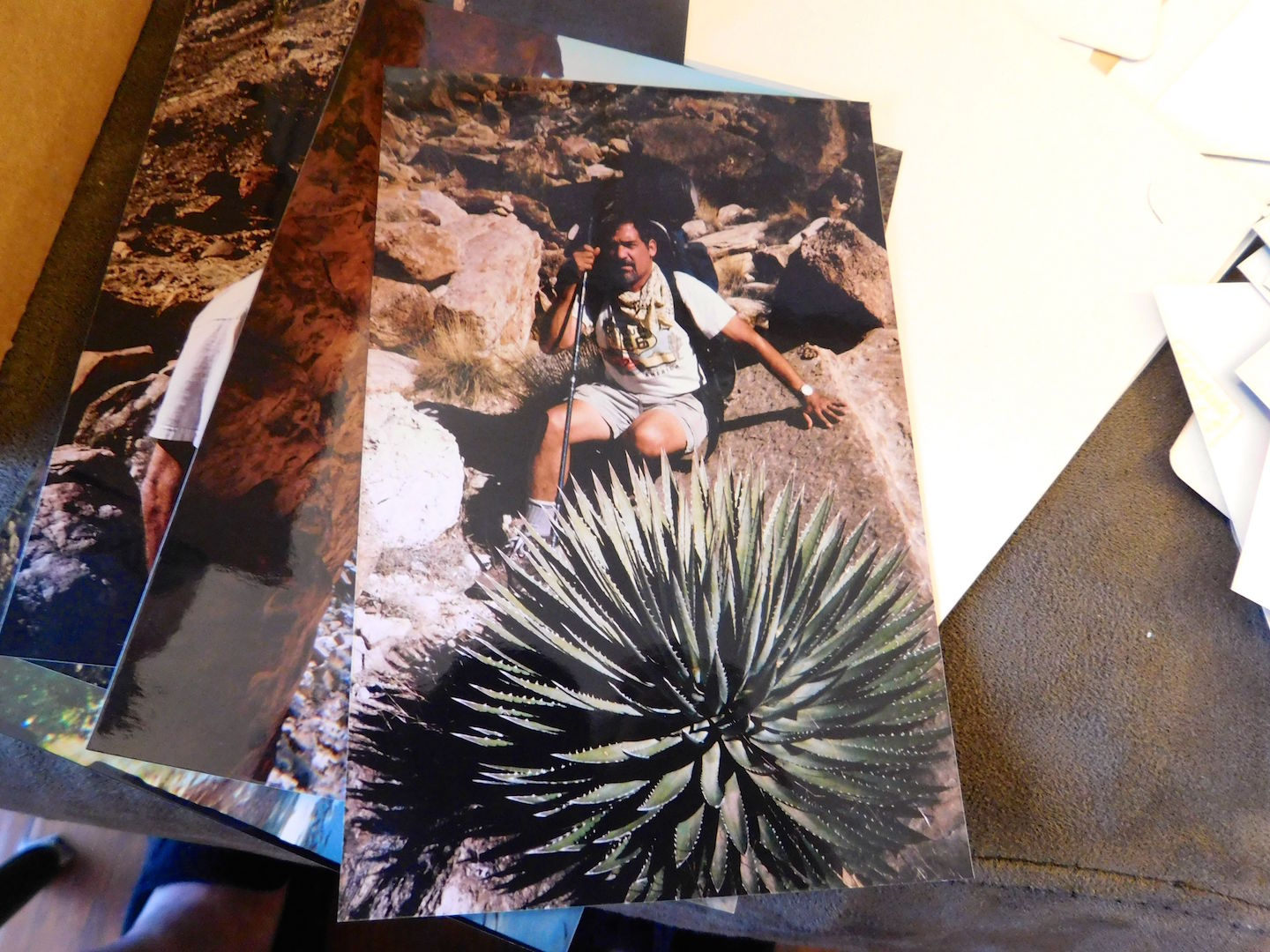
Steve Salt Trail 2002 b.jpg
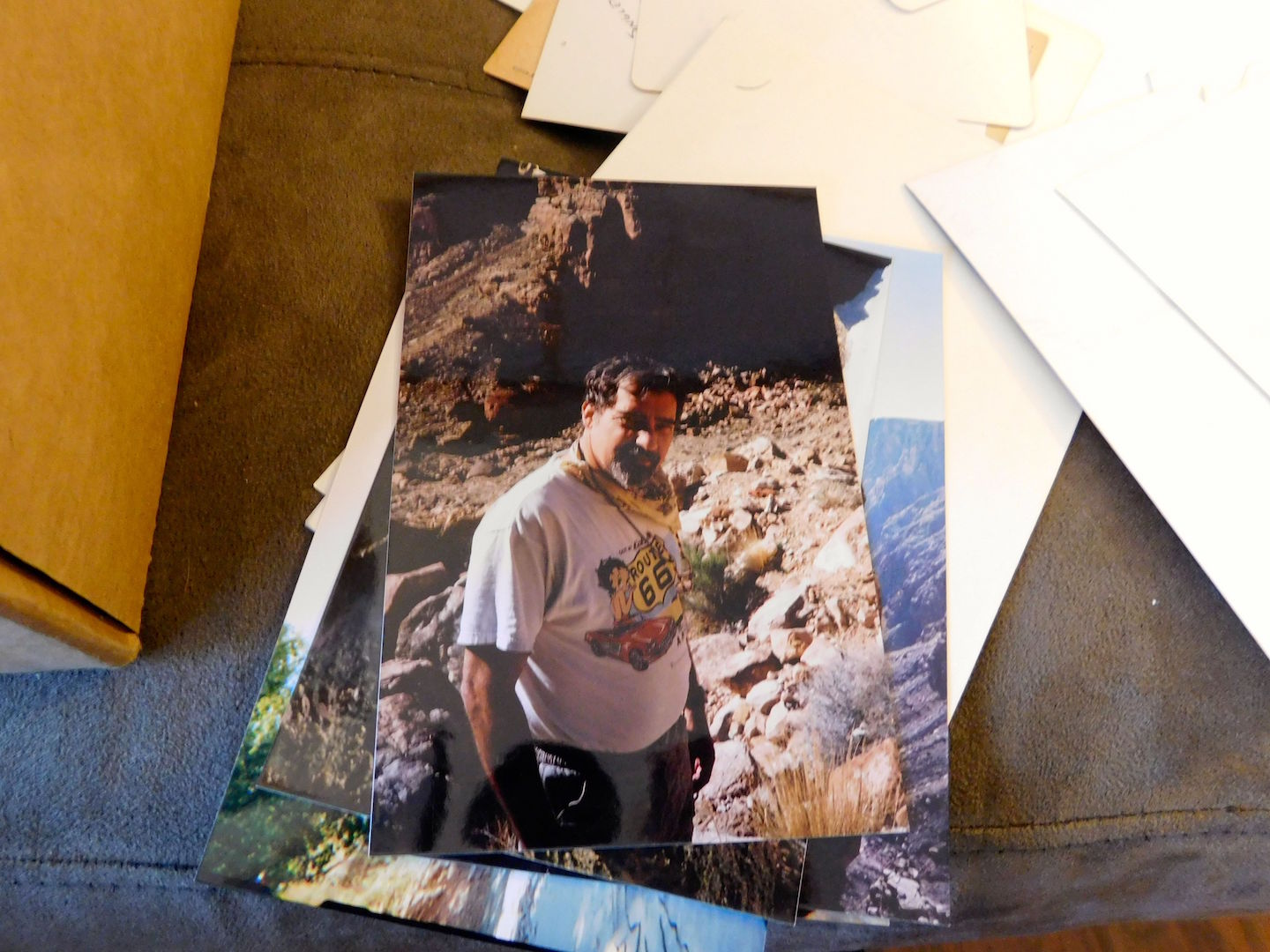
Steve Salt Trail 2002 c.jpg
My brother
Tom and I stand on a hill and look down into Salt
Trail Canyon just downstream of Bekihatso Wash and
see as Don Talayesva did almost a century before,
the Little Colorado “shining from the bottom.”
This is an obvious passage to the river because
from the rim you can see far in the distance
below, radiant in the sunshine, the beckoning blue
water and rushing white falls. Getting here has
been something of a business. The route across the
Reservation to the trailhead begins north of the
Tuba City cutoff, already close to the middle of
nowhere, and then travels on dirt roads over
twenty-five miles of red rock and open space.
Again, canyoneer Bill Orman has mailed me a
detailed road log. But it has been a year or so
since he has visited Salt Trail Canyon and he does
not know that a small landmark marking a crucial
turn, a red metal sign with a number, is no longer
there.
On our way here, we have chosen a small side road,
and though it was the wrong one, we eventually
connect to the correct path and picked up Bill’s
other carefully recorded landmarks: three beat up
hogans on the left, a small cluster of whitish
stones, the round rock foundation of an ancient
hogan. Soon we pass a flock of sheep and a pack of
sheep dogs tears across the desert to intercept
us. A wildly woolly black and white, tassel-eared
dog barks angrily at the door. Tom guns the engine
but the fast, protective dogs follow a quarter of
a mile before they are satisfied that the sheep
are safe. I see them in the rearview mirror, no
longer running, but still barking and sneezing and
licking their noses in the cold air.
Now as we look into the canyon, a bright red Chevy
pickup descends a hill and parks beside us. We
chat for a while with the driver, a Navajo hired
to watch the sheep. He knows quite a bit about the
canyon. He tells us that when he was young he once
descended Salt Trail Canyon and trekked all the
way to the confluence and exited out Beamer and
Tanner. He offers few details of the trip except
that he had lost his wallet somewhere in the Gorge
and that it was returned months later by
ichthyologists studying the Little C’s fish.
“It’s very steep in there,” he says, and
points to a small cairn marking a faint trail into
the wash above the drainage. “You start there and
then go down to where it drops in. It’s very
steep.”
“You still go in there sometimes?”
He laughs. “I’m not in condition anymore.”
Talking with him is exceedingly pleasant. Right
away I recognize the type. Typical of Navajos, he
has a soft Indian accent and a modest manner which
might have be mistaken for innocence but which is
really only civility.
Tom and I drag our packs out of the truck bed.
They are heavy. We are packed for a winter hike.
We’d spent an icy night near Flagstaff where the
temperature had fallen to the low twenties and I
don’t know how much warmer it will be as we
descend into the Canyon. We are loaded with down
coats, gloves, sweaters, wool caps, long fleece
pants and heavy sub zero sleeping bags. Accustomed
as I am to hiking in the heat, it is difficult to
put aside the urge to pack a lot of water. We
carry a gallon each.
The trail leads down between two tall cairns which
stand like sentinels to the Gates of Mordor. From
here the route fairly plunges over the edge. While
hiking the Horse Trail with a big pack is
challenging, and Blue the Spring Trail
perilous, The Salt Trail is, well, medium
dangerous, at least for us. There are few places
to make a straight-air fall, but there are plenty
of spots to stumble and break every bone in your
body. For the hardcore canyoneer, the passage may
seem a dreamboat with just enough challenge to
make it interesting. For my brother and me,
however, it’s different. With the heavy packs
balanced on our backs, working down the chute of
jumbled yellow blocks is difficult and scary. Tom,
in particular, is at a disadvantage. Although he’s
a strong hiker, he’s not all that fond of it; he
has only come along because he wanted to look at
birds. Those heavy, three-hundred-dollar Swift
Audubon binoculars swinging from a strap around
his neck aren’t helping much. Despite my warnings
of what the terrain might be like, he had still
imagined walking upright on something resembling a
trail. In addition to this, he has ignored my
advice and stuffed into his pack many glass
bottles of Redhook beer. He has decanted a pint of
another specialty brew into a plastic canteen
stuffed into a side pocket. The cap is loose. A
hoppy aroma follows in his wake. Worst of all, he
is a studied doomsayer. At every precipice he
imagines a fall and supplies with many adjectives
the details of shocking compound fractures. If I
point out an interesting rock, he is apt to make
dark allusions to its precarious position and
comment on the damage such a heavy object would do
if it were to trundle over your skull. In the
distant roaring of jets, he imagines approaching
flash floods and often pauses to evoke appalling
visions. All this crepe hanging fills me with
dread. My mind is laden with morbid thoughts of
tragedy and catastrophe.
Granted, he isn’t enjoying my company much either.
My pedagogical lectures on the use of a walking
stick are wearing him down. I can’t help it. He
considers the stick an inconvenience, just
something else to carry or trip over. When I
express my exasperation at his refusal to be
instructed, he suggests a use for the stick not
mentioned in the REI brochure.
There is also the matter of his shoes. Tom doesn’t
have any heavy- duty boots so I have lent him my
old pair of freshly-resoled Zamberlans. They are
not working out. Behind me I hear a hair-raising
shriek which chills my bones. I turn to see him
doing a sloppy pirouette against the sky. Then he
lunges for the rock and clings for dear life with
both arms to a coffin of sandstone. I’m thinking
that this prophet of doom may be right. “It’s the
shoes,” he says. The new waffle tread, he claims,
sticks to the rock. I don’t know what he’s talking
about. “It’s like walking across glass with
suction cups,” he insists. I think he’s crazy but
we swap shoes. Surprisingly, this seems to help.
Below the worst of the boulder jam soars a
towering pillar of Moencopi sandstone. Leaning
against the base of this pillar was once a rock
adorned with carvings and paintings of chickens,
the Chicken Shrine. I see no pictures on any of
the stones here now, but when Don Talayesva hiked
the Salt Trail in 1912, he and his companions left
offerings of dough and feathers here and crowed a
little in order to assure success with poultry.
The other places chronicled in Talayesva’s account
are perhaps impossible to recognize because the
descriptions of them are vague. The Chicken
Shrine, however, was undoubtedly at the foot of
this unmistakable spire. Along the way, I have
looked for rock art or pottery, but there is
nothing. Bill Orman has told me that he once
discovered, a little off the route, a large
portion of an Anasazi pot decorated with a jagged
black and white design. He also described to me a
place where straightened sticks, looking a little
like arrow shafts, were concealed in a small cave.
I find the spot and take some pictures. Just what
these sticks mean or how old they are is a
mystery, though they appear as if they are some
kind of an offering. In another small alcove lower
in the formation, I find another dowel-like stick.
Bill Orman has also told me that atop the Redwall
above the river lie two large cairns of jasper. A
Hopi friend told him that these were built by Hopi
pilgrims over the centuries. At the end of a Salt
Expedition each devotee would, it was said, leave
a single stone. If this story is true, it might
well provide a documentary record of the
expeditions from ages hence. An archeologist could
count the stones and arrive at the number of
devotees who had made the journey. It would be
reasonable to assume, of course, that the
tradition of placing a rock did not necessarily
start with the first or even the hundredth
pilgrimage, but it would tell how many had
worshipped at the Salt Mines or the Sipapu since
the tradition started. Another Native American
friend of Bill’s, however, said that these cairns
looked like graves. The story behind these rock
piles may never be known. Looking to Sun Chief
does not help to resolve the question; Don
Talayesva mentions nothing of these cairns in the
record of his Salt Expedition.
Tom and I descend farther into the canyon
following cairns. It’s easy to stay on course and
the canyon relents a little from time to time; we
sometimes find ourselves striding along on an
obvious trail. On the left-hand side of the
canyon, for instance, a long, flat stone “walkway”
traverses an overhang along a wall. Nearby, in a
sandy little basin above a huge, dry plunge-pool,
we drop our packs. Getting dark. We have passed
small tinajas full of water, each of them
reminding me of the weighty load I’m bearing on my
back. I haven’t drunk one drop. We spread out our
flimsy pads and drape our heavy Hollofil bags on
top.
Winter is a quiet time in the canyon. We have seen
no lizards, no squirrels, not even insects, aside
from a few pallid winged grasshoppers. Tom’s total
bird count: one rock wren. We boil water on my
tiny Honeybird gas stove and pour cups of boiling
water into pouches of freeze-dried backpacker
stroganoff and lasagna. I’ve left my wood burning
stove at home. Though it is convenient on a long
trek, on a short one it is not worth the hassle of
keeping the thing stoked and putting up with soot
begrimed pots.
I prepare dinner with such care that I wonder a
little if cooking is not the entire object of the
hike. Into the lasagna I dump the entire contents
of a small container of parmesan cheese which I
stir in with chopsticks. I also add a square of
real longhorn cheddar, a handful of dried
mushrooms and a spoonful of dehydrated onions.
I’ve got something else also. Wonderful Mexican
Cotija cheese, salty and rich. I crumble a chunk
over the top. To make it even better I include a
special ingredient–chile pequin. This is in the
form of an orange powder I have prepared by
pulverizing the small, dried chiles in a coffee
grinder and sifting the result through a wire mesh
so that no remnants of the yellow seeds remain.
Hotter than the hubs of Hell, a small pinch
sprinkled over any dish will add the necessary
fire. Every hiker has his own crazy ingredients;
dreaming up recipes is half the fun. The light
continues fading, and as we finish eating, I feel
a sense of satisfaction that we have timed things
well enough to avoid the misery of cooking in the
dark.
Soon it is night. Satellites fall across the sky
and the long white needles of meteors flare like
sparks struck from flint. We watch Orion, the
seven sisters, and just under the canopy of stars,
the silent lights of passing planes which I
imagine are glittering indecipherable codes, each
spelling a single word over and over. We lean back
against a stone drinking cold, bottled beer. Tom
says he sees ghost lights twinkling like fireflies
against the black shadow of a cliff and I’ll be
damned if I don’t see them too. After a while the
rising moon turns the sky into a mistiness full of
light and depth, the cliffs emerge from the
shadows, and the mysterious lights disappear.
You don’t see such shows of light either real or
imagined with a roof over your head. My friends
who don’t hike often seem appalled when they learn
that I rarely pack a tent. They shudder to imagine
a night uninsulated by at least a protective film
of nylon. But having walked away from the
machinery of civilization, I am completely at
ease. The closest automobile is the one we left at
the rim miles away. But aren’t there mountain
lions, they ask. Not many, and what good would a
tent do? The claws of a lion bent on my demise
would slash like straight razors through any
fabric. But snakes, they insist. Aren’t you afraid
of snakes? Not really. Rattlers are uncommon here
and I would count seeing one as a benefit. I have
yet to see a pink Grand Canyon rattlesnake.
Admittedly, a snake bite here would be nothing but
trouble. Tom’s doomsaying makes me dwell on this a
little. What exactly are the chances of a
rattlesnake bite? Aside from their scarcity, the
fact that rattlesnakes are not particularly
aggressive makes them unlikely assailants. I have
read that the profile for a rattlesnake bite
victim generally involves the following scenario:
male in his twenties, drunk, holding snake. Most
other bites occur when the dumbbell is trying to
harass or kill the rattler. Stumbling upon a
rattlesnake or sharing a sleeping bag with one are
not common ways of getting bitten.
I recall a snake story which occurred near the
ultimate terminus of this very drainage. In his
classic account of his 1907 expedition to Sonora’s
Pinacate mountains, Camp-Fires on Desert and Lava,
William Hornaday recounts an anecdote which
suggests that even a snake in the hand may not at
times be any more dangerous than one in the bush.
The story regarded his geographer, Godfrey Sykes,
who wished to set his aneroid for a more accurate
measurement of the Pinacates’ elevation. The only
sure way to do this was to walk to sea level, to
the sandy shores of the Sea of Cortez, a couple
dozen miles to the south. There he could set the
pressure-altitude indicator of the device to zero.
Aside from being a good geographer and as
respected a writer as Hornaday, Sykes was also one
hell of a hiker. One morning, without telling the
others, he set out for the sea. Having made the
difficult crossing of the sand hills, he found
walking across the flats easy. At the gulf, he
adjusted the scale of his instrument and after
gathering a few shell specimens for Hornaday, he
started back. The full moon illuminated the way
and he arrived at camp at half past one that
morning. His pedometer measured 43 miles. There
was, however, an incident on the way back. I best
let Mr. Sykes tell the rest of it himself:
“The net zoological result of my pasear was a few
little birds of unknown species, a jackrabbit or
two, a coyote and a little coiled up rattlesnake
evidently suffering from the chilly night air. I
put my hand on the snake, thinking it was a shell,
and never discovered what kind of snake it was
until, as he slid through my fingers, I felt his
rattles! At that I bid him a hurried adieu and
left him to find warmer quarters.”
I know only one person who has suffered a
rattlesnake bite. My friend of many years ago, Joe
Kraig, was once bitten by a sidewinder. He was
trying to force feed a pet rattler by stuffing a
mouse down its throat. In the process he
inadvertently inserted his thumb into the snake’s
mouth. Both fangs got him. In this case the bite
should not have been a dangerous one because, as a
precaution, Joe had milked the sidewinder just
before attempting to feed it. Joe squeezed his
thumb and two pure red droplets appeared. No venom
seemed to have been injected. Thinking he was in
the clear, he put the snake back into its cage and
went about his business.
A half hour later he noticed a dark red line of
discoloration moving slowly up his arm following
the course of the radial artery. His wife called
the hospital and soon he was greeted by the
excited staff of doctors, nurses, candy stripers
and janitors who were waiting eagerly at the
emergency room door. By now Joe’s face was
swelling up. I don’t remember whether he was given
antivenin or not, but the snake nearly killed him.
Joe was always careless with snakes. He was
intrigued by them and collected all kinds. One day
on the Reservation along I-40 near Sanders, Joe
stopped to pick up a hitchhiker, a guy he knew,
Emerson Roanhorse, who was hitchhiking along the
frontage road. “Ya’ ‘at eeh, Emerson. Where you
headed?” Emerson pointed ahead Navajo-style with a
pursing of the lips and an upward nod of the head.
“Goin’ to my Aunt’s, Joe. Right up here by Houck.”
“How’s your sister doing, Emerson?”
“She’s okay. Working at Whiting Brothers.”
At this point, Joe braked for a stop sign and a
burlap bag slid out from under the front seat. A
rattler slithered out. As a general thing,
Navajo men are not much shaken by rattlesnakes,
but the unexpected appearance of one inside a car
is enough to test anyone’s resolve. Joe’s
passenger must have weighed two hundred pounds,
but he went through the window like a jackrabbit.
The window was rolled half way up and how he got
through without breaking the glass is hard to say.
Joe was immediately contrite. “Damn, I’m sorry,
Emerson. I didn’t know that would happen. Hang on.
I’ll resack him.
“Ah, Ch’iidii! You dumb bastard. Why don’t
you tell me you got a snake in there. Are you
crazy?”
“Sorry. Sorry.”
Emerson cooled down.
“Just put him back in the bag. Hurry up. I’m
already missing dinner.”
Another time, on holiday, Joe was tubing
down the Salt River near Phoenix when he came upon
a fine black and yellow king snake in the brush
along the shore. Enthusiastically, he grabbed it
and wrapped it around his neck and began paddling
to meet his party of friends at an island in the
middle of the stream. Now the king snake has a
reputation for being an amiable creature, a fair
pet as far as snakes go, but this one opened its
mouth and grabbed the soft flesh of Joe’s throat
like the clamp on a jumper cable. At the island
Joe paced up and down the shore cradling the
snake, followed by his sympathetic companions.
Meanwhile, floating clusters of tubers, many beery
and unsteady on their feet, arrived at the island
full of pitying interest. A crowd began to gather.
Joe and his snake had become a riparian
attraction. “Over here!” someone would yell across
the water. “A guy’s got a snake on him. Hangin’ on
his throat!”
“No shit?” Then, “Damn! I’m stuck in an eddy.
Don’t let him get away. I’ll be right there.” (The
sound of furious paddling)
Joe was thinking that he could do without a
portion of this attention. His main concern was
how to dislodge the snake without injuring it.
Every one of the hundred and ten spectators,
though, had the same idea. “Burn him off!” they
cried. “Here!” and they each thrust a flaming Bic
lighter in Joe’s face.
Even with the snake hanging painfully from his
neck, Joe couldn’t help but marvel at the
excitability of these wet, slightly-toasted
individuals. Almost all of them had lighters which
they adjusted so that a foot of orange flame
gushed out. Inspired by many twelve packs, they
were fired with an earnest desire to serve him, a
boozy sympathy, a philanthropic zeal almost. But
at this point all Joe wanted was for them to go
away. “Jump in the water,” one suggested.
“Drown the sonofabitch off.”
That seemed like a fair idea. Joe jumped in.
In the annals of human arrogance there is scarcely
an example which equals Joe Kraig’s attempt to
hold his breath longer than a king snake. In
short, he couldn’t do it, and these two marvels of
nature remained connected until the reptile tired
of the game and dropped off of its own accord.
In the morning Tom and I leave our packs at our
camp in the wash and trek down to a deep fissure
with huge impassable pour-offs. The route crosses
the wash above and ascends in the form of a faint
trail to the top of the Redwall where it continues
a long pace before dropping down to the river. We
trudge up the steep slope. Below we see the
shining water. The bluest river in the world? I
have no doubt, though as I have mentioned, it has
another face when it runs a walnut brown and at
the confluence it mixes with the green water of
the Big Colorado the way cream swirls into coffee.
We’ve been here long enough. I’ve promised
my young son that I’ll stay closer to home. He
worries that I’ll never come back. He shouldn’t.
The eight days I spent in the Gorge with my
brother Jeff were the longest time I’d ever spent
away from him, and I wonder a little that it has
already been two years since Jeff and I walked
along the sands of the turquoise waters below Salt
Trail Canyon. Just what dreams compelled us to
hike the Gorge are already fading into memory.
Many wilderness travelers express their desire to
find a spiritual enlightenment in nature, an
answer to the mystery of their lives. I am all for
this, but personally have long since given up such
seeking, for to me the answers seem only to appear
in the form of the most arcane metaphors, at best
disquieting and always indecipherable. I count
myself then, superfluous? fortunate to have
been so untroubled by spiritual longing for I
suspect that this is because I have found enough
to satisfy me. An experience itself unencumbered
by a recondite quest is more than sufficient.
I remember a Navajo woman I once bought jewelry
from asking, “Why do you do that? Why do you go
down in there?”
“For fun,” I told her, and it was a true answer.
The river is just as I have remembered it, a milky
blue. We have no time to linger here. We have jobs
and obligations. Against my inclinations, I try to
sense something of myself in the huge and timeless
canyon and find nothing. Time flies more quickly
for a man than it does for a canyon and a canyon
has no promises to keep. We ascend to a high place
overlooking the shining blue river and listen to
the white sound of rushing water.
|
<video controls="controls"
src="Salt%20Trail%20November%202002%2018.mov"
width="420"
height="345"> Your browser does not support
the HTML5 Video element. </video><br>
salt%20trail.mov
|
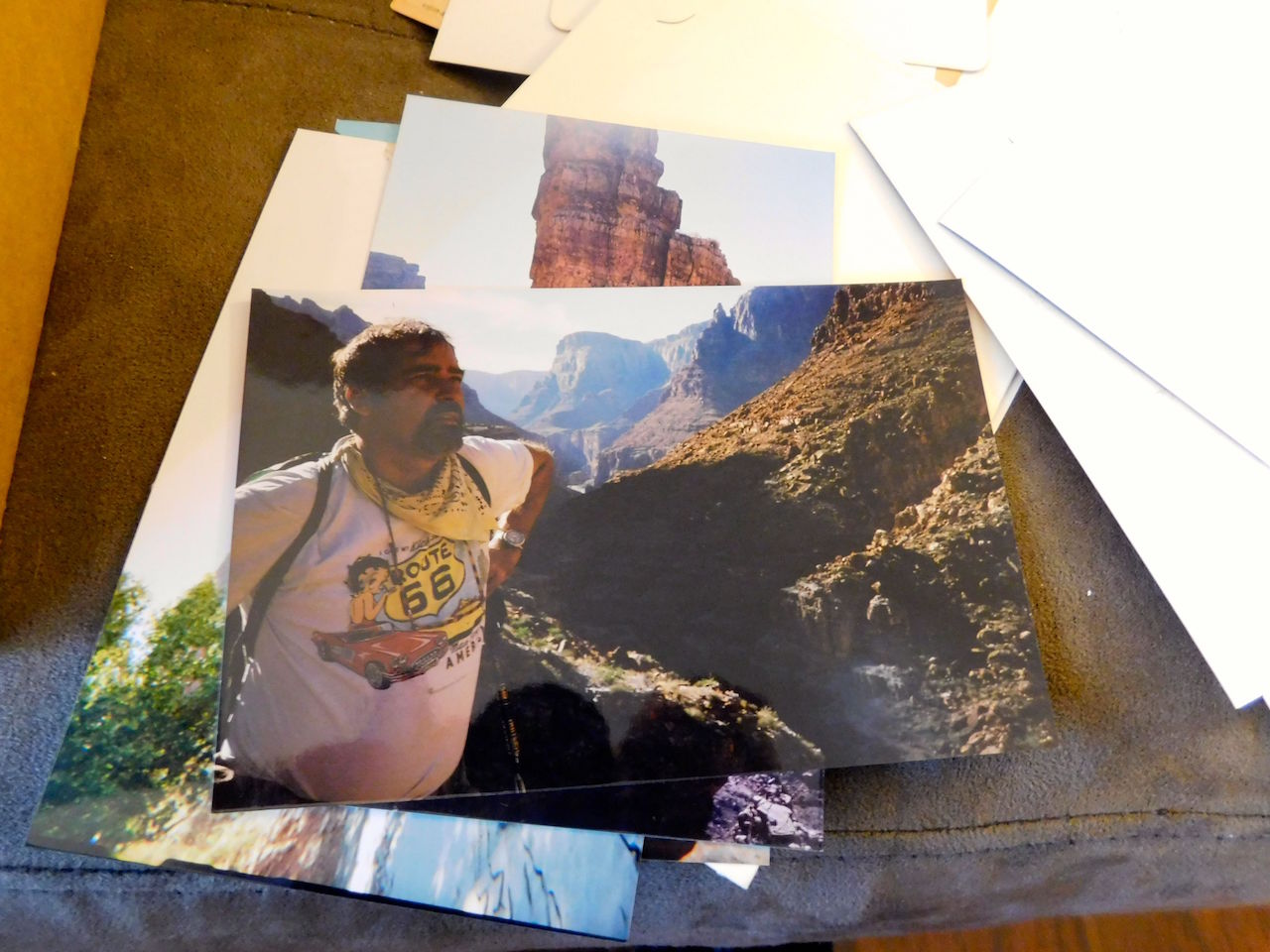
Steve Salt Trail 2002 d.jpg
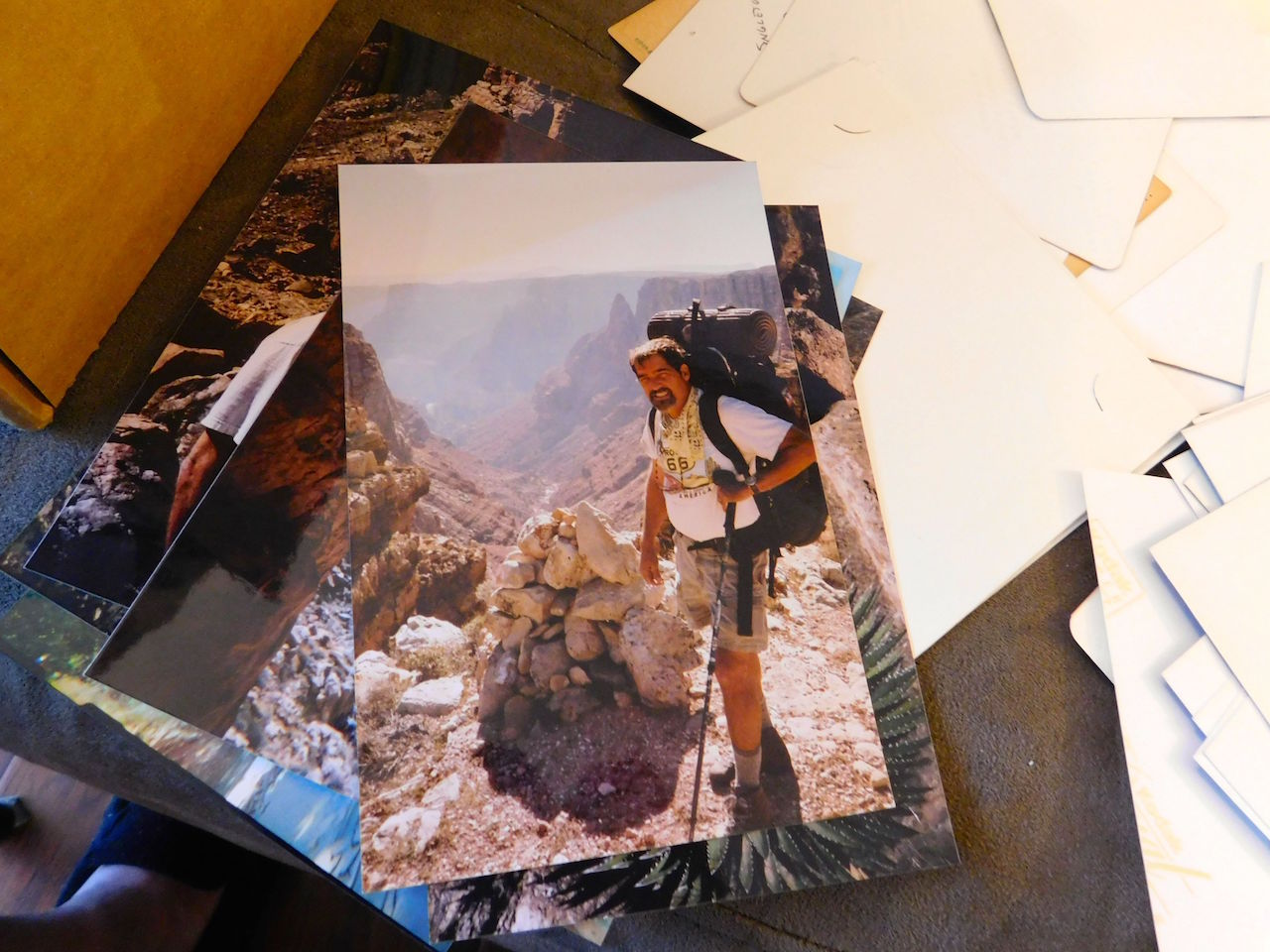
Steve Salt Trail 2002.jpg
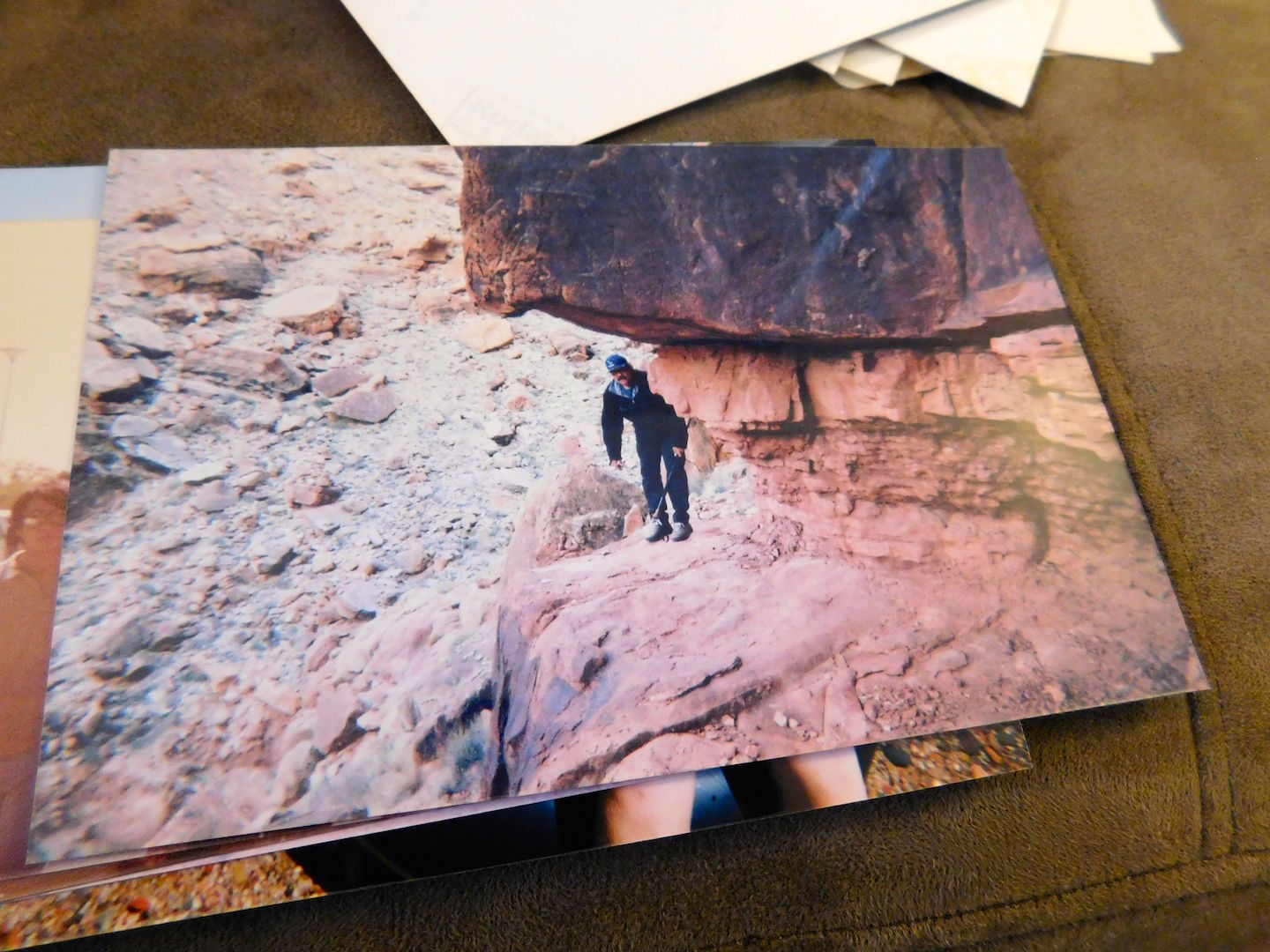
Tom on the Salt Trail 2002.jpg
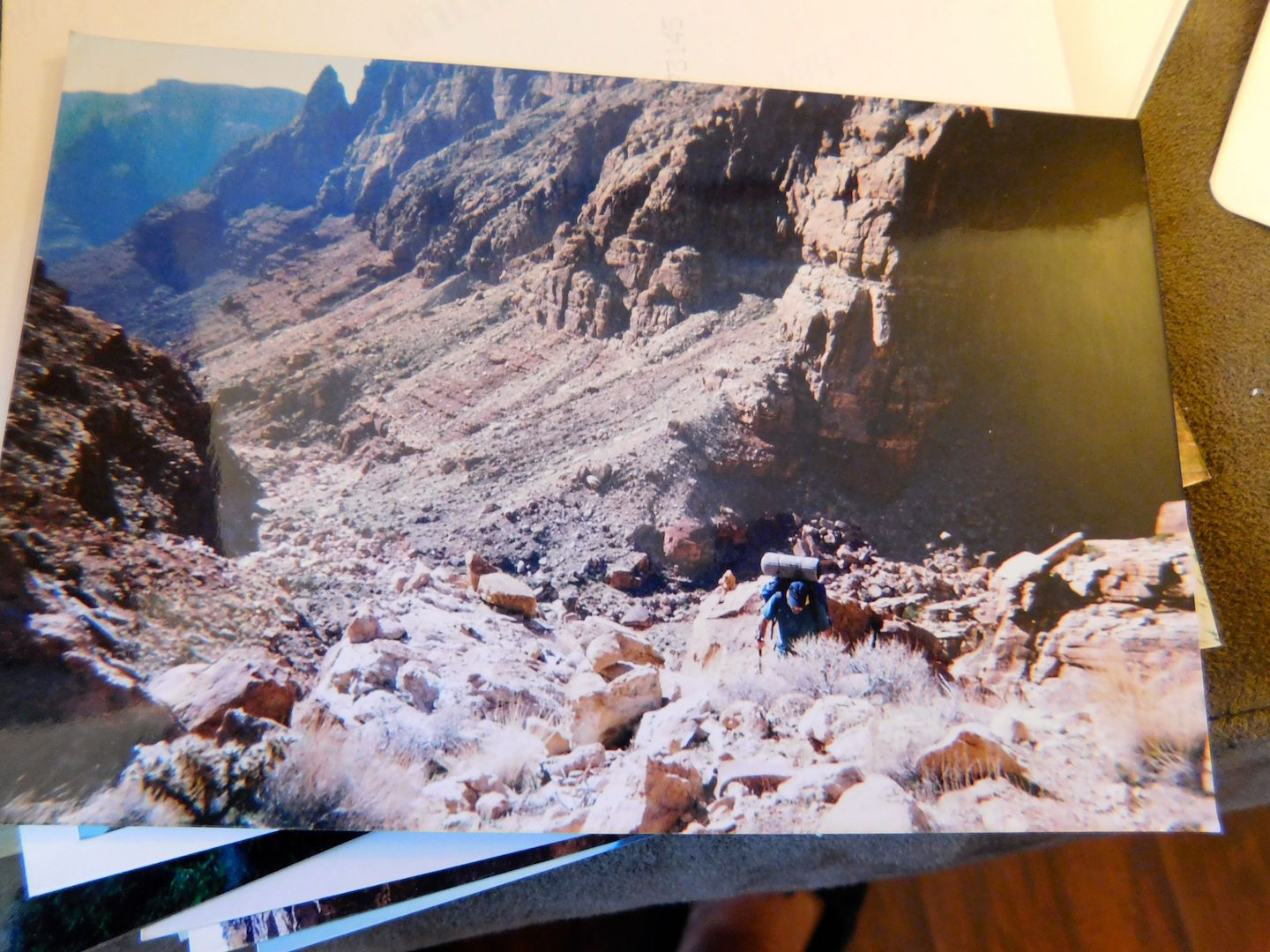
tom Salt Trail 2002.jpg
|









